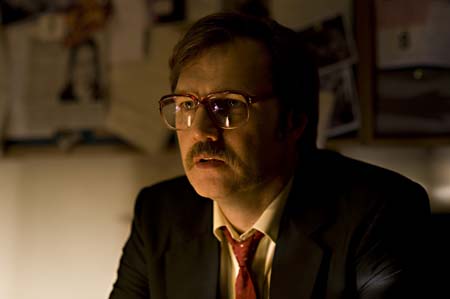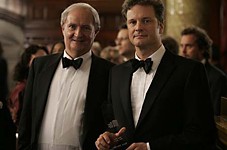
Red Riding: 1983
2009, NR, 100 min. Directed by Anand Tucker. Starring David Morrissey, Mark Addy, Warren Clarke, Peter Mullan, Robert Sheehan, Jim Carter, Shaun Dooley, Daniel Mays, Gerard Kearns.
REVIEWED By Kimberley Jones, Fri., March 26, 2010
In the Red Riding trilogy, a long-form examination into corruption and man’s capacity (even proclivity) for evil, we’ve seen various characters called or identified by a pig, a swan, a badger, an owl, and a wolf. But in this final installment, it’s the sacrificial lamb that comes to the fore. Red Riding: 1983 cycles back to the terrible events set in motion in Red Riding: 1974, when a series of young girls went missing and a mentally retarded man, Michael Myshkin (Mays), was wrongfully convicted for the crime. Detective Inspector Maurice Jobson (Morrissey), a regular if mostly background character in the first two films, becomes our first focal point here as a man deeply wracked by his complicity in the Yorkshire Constabulary’s general lawlessness. (“To the north,” goes the dirty cops’ back-slapping mantra, “where we do what we want!”) When, in 1983, another young girl disappears, Jobson decides to do some actual police work, reopening several old cases his colleagues would prefer to keep closed (or buried) and sniffing around the likes of series constant Rev. Lawes (Mullan, with the omniscience and eerie stillness of a very dark angel). Simultaneously, in the trilogy’s first dual narrative, another lead emerges in the form of “right fat bastard” John Piggott (Addy), a sad-sack solicitor and Yorkshire native who reluctantly agrees to file an appeal on behalf of Myshkin. Piggott marks the trilogy’s most uncomplicated hero; his obvious humanity and grim-grin humor about himself and the general awfulness all around him leaven what has been a torturous ride down to the depths of depravity. RR: 1983 is at once the most confusing of the three films, with its long stretches of unannounced/unheralded flashback, and also the one that gives us most clarity, if not completion. There are some needling loose ends – whatever happened to the whey-faced Bob Craven (Sean Harris), part two’s monster cop? – but there’s still a great deal of satisfaction to be had in both the resolution of the plot’s many mysteries and the thematic throughlines of the three films. Breaking from RR: 1974’s gritty 16mm and the formal beauty of RR: 1980’s 35mm, Tucker uses the hyper-detailed Red One digital camera, which frequently produces flares that bisect the screen (far less distracting than in J.J. Abrams’ Star Trek). The effect recalls images from the previous films – RR: 1974’s crisscrossing lines denoting abduction sites on a map of the Riding districts, abstractly and artfully mimicked in the opening credits of RR: 1980. The lesson, so powerfully dramatized in this under-the-skin, utterly engrossing series? Everything is connected, and neither corruption nor redemption happen without the assist of others.
A note to readers: Bold and uncensored, The Austin Chronicle has been Austin’s independent news source for over 40 years, expressing the community’s political and environmental concerns and supporting its active cultural scene. Now more than ever, we need your support to continue supplying Austin with independent, free press. If real news is important to you, please consider making a donation of $5, $10 or whatever you can afford, to help keep our journalism on stands.
Marc Savlov, Jan. 8, 2010
Marjorie Baumgarten, July 4, 2008
April 22, 2024
April 19, 2024
Red Riding: 1983, Anand Tucker, David Morrissey, Mark Addy, Warren Clarke, Peter Mullan, Robert Sheehan, Jim Carter, Shaun Dooley, Daniel Mays, Gerard Kearns









